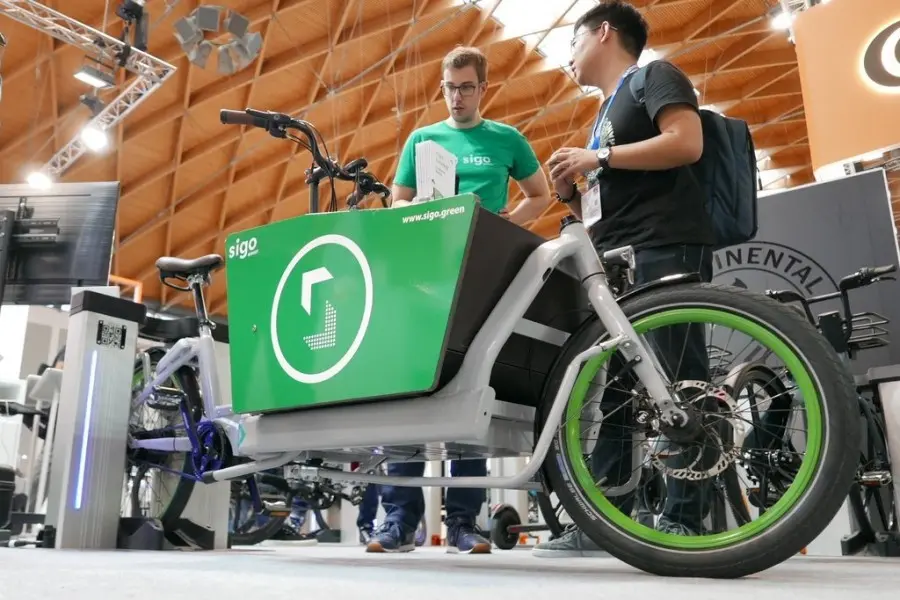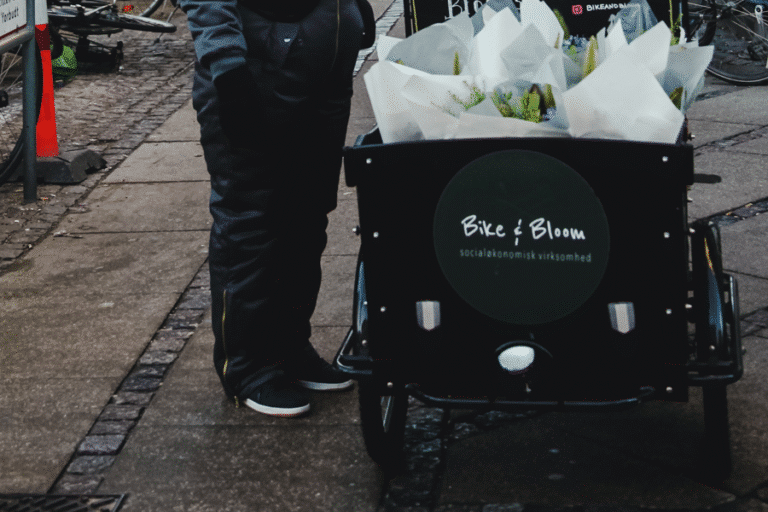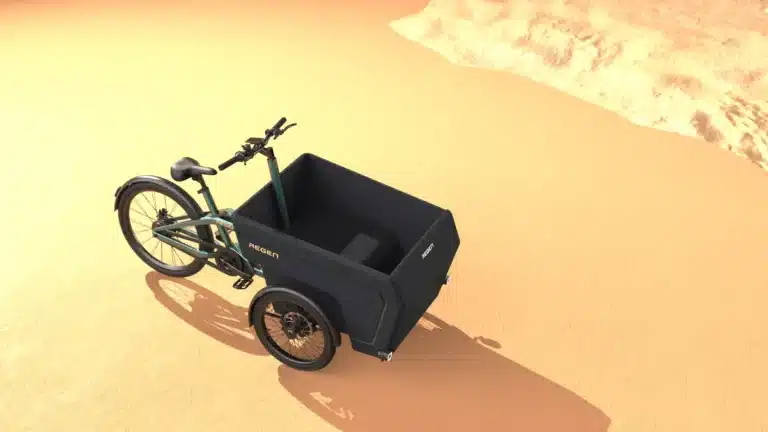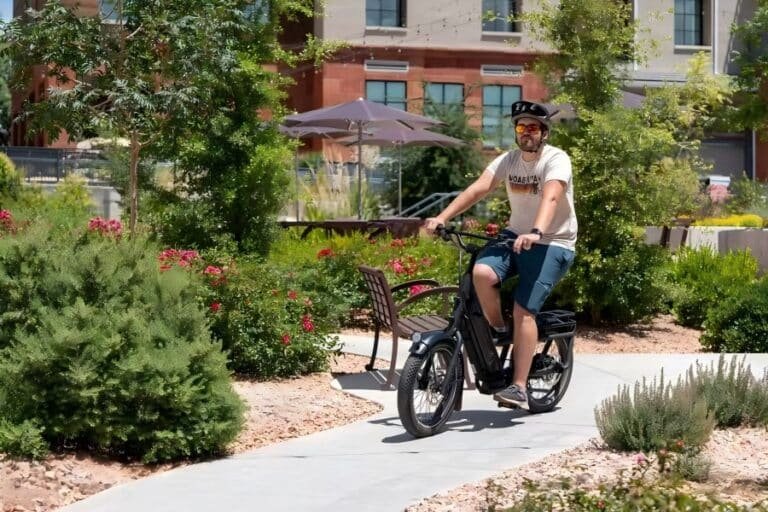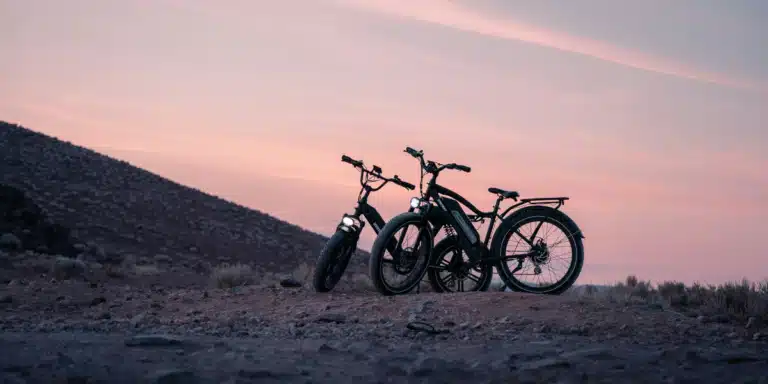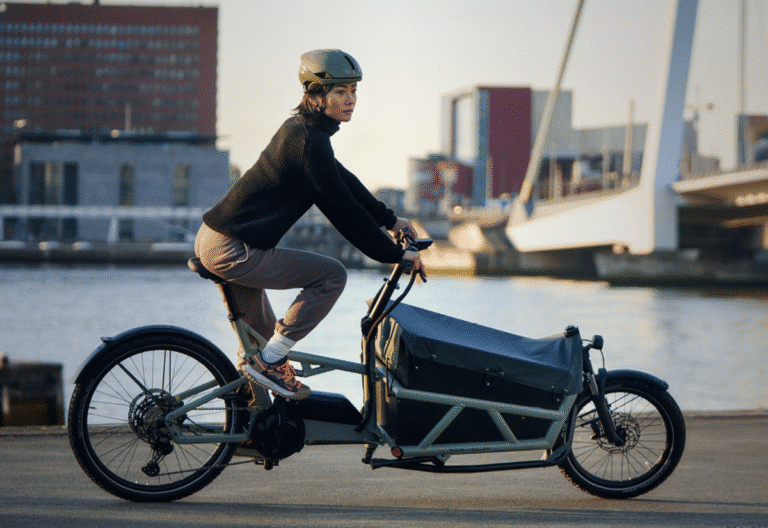Electric cargo bikes – including two-wheeled Long john bikes, three-wheeled trikes, and even four-wheeled pedal-assist quadricycles – are transforming how goods are delivered across Europe. These bikes provide a nimble, zero-emission alternative to delivery vans in dense cities, often delivering goods faster and more efficiently. One study found that electric cargo bikes complete urban deliveries 60% faster than vans, averaging 10 parcel drop-offs per hour compared to a van’s 6, while cutting carbon emissions by 90% versus diesel vans. Major parcel services and grocers have embraced e-cargo bikes to reduce congestion and meet climate targets. For example, DHL and Deutsche Post operate over 17,000 e-bike and e-trike units in Germany alone, and UPS, DPD, Amazon and others have launched e-cargo bike fleets in cities like London, Paris, and Hamburg. This report provides an in-depth look at the types of electric cargo bikes used for logistics, grocery delivery, postal services, and B2B distribution across Europe – from classic two-wheelers to high-capacity trikes and quads – including their key features, examples of popular models, and typical price ranges.
Types of Electric Cargo Bikes used for logistics
European e-cargo bikes come in several distinct configurations, each suited to different use cases. Below we define the major types and their characteristics, with examples of brands and models widely used in commercial operations. We also include comparison tables of technical specs (payload capacity, range, etc.) and approximate prices in Euros for representative models.
Two-Wheeled Front-Loader Cargo Bikes (Long John style)
Description: The two-wheeled front-loader, often called a “Long John” or bakfiets, has an elongated frame with a cargo box or platform between the rider and the front wheel. This classic design dates back to 1920s Denmark and remains popular for transporting heavy loads or multiple children. The rider steers via a linkage to the distant front wheel, and the low-mounted front cargo box offers stability for bulky loads. Long Johns have two wheels (one front, one rear), so they handle more like a regular bicycle (leaning into turns) but with a longer wheelbase. They are narrower than trikes, making them agile in city traffic and able to use normal bike lanes, though their length means a larger turning radius.
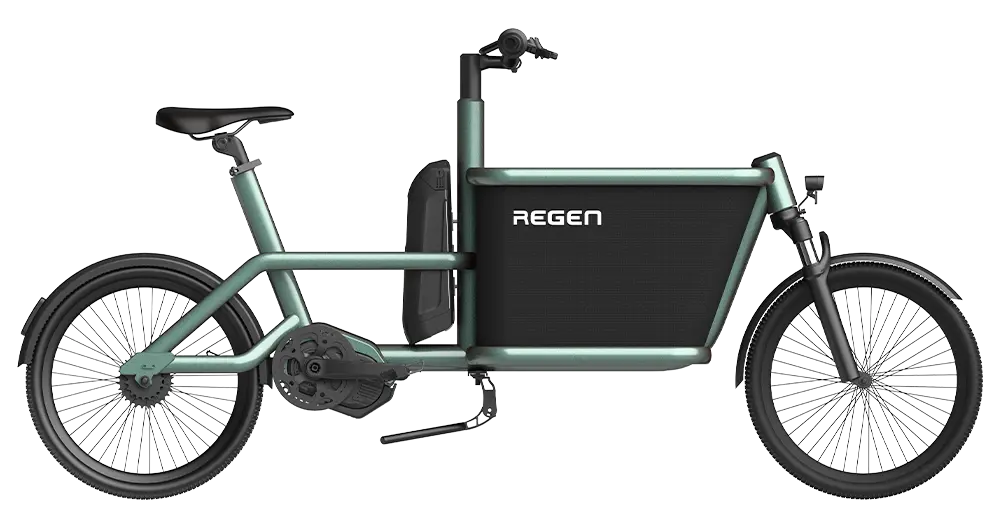
Regen 02 E-Cargo Bike
Look for a Compact, Customisable Front-Loader for Your Brand?
TÜV-tested through past custom projects. Publicly available model—configurable, proven, and ready to scale.
Key Features: Modern electric Long Johns typically have a sturdy aluminum or steel frame, an electric assist motor (250W mid-drive on many models) for hauling cargo, and cargo boxes ranging ~125–250 liters volume. Payload capacity is usually around 80–125 kg in the front box, with total gross weight (rider+bike+cargo) often capped around 200–250 kg. For example, the Urban Arrow Family/Cargo model allows up to 125 kg in the front compartment (and ~250 kg gross). These bikes use powerful e-assist systems (Bosch Cargo Line or similar) to provide high torque for hills, typically limited to 25 km/h assist per EU pedelec regulations. Battery range is on the order of 30–70 km per charge depending on battery size (500–1000 Wh common) and load – roughly 50 km on average with one battery. Some models support dual batteries for extended range on long routes. Many have gear hubs (Enviolo, Rohloff) or robust derailleur drivetrains and often feature extras like hydraulic disc brakes (for safe stopping with heavy loads) and suspension forks or even full suspension on premium models (e.g. Riese & Müller Load) to protect cargo from bumps.
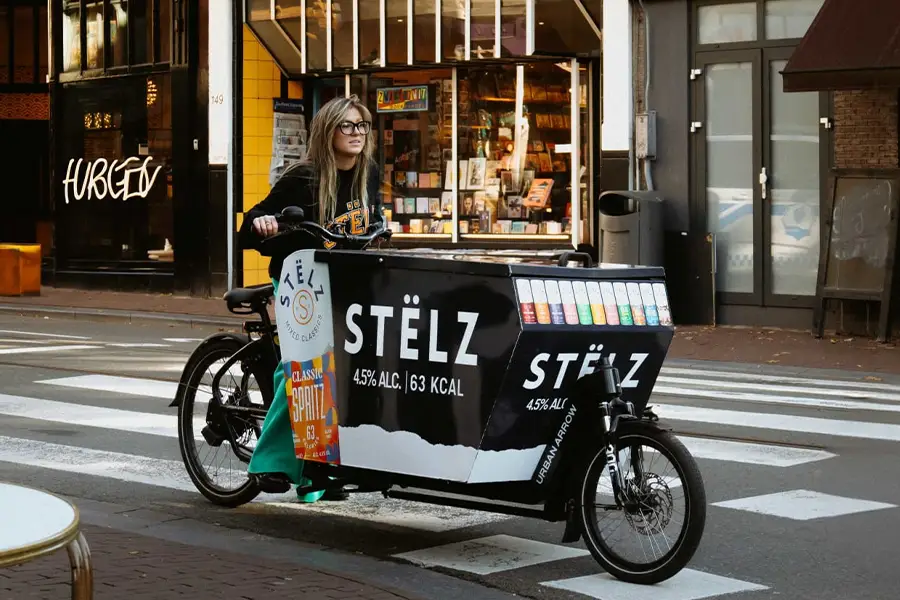
Notable Brands/Models: In Europe, Urban Arrow (Netherlands) is a leading brand – their Cargo L/XL front-loaders are widely used by logistics firms and municipal services, even available in DHL or UPS liveries. Other popular models include the Larry vs Harry eBullitt (a lightweight Danish long john with ~180 kg gross capacity), the Riese & Müller Packster 70 (a high-end German front-loader with ~240 L box and ~250 kg GVW, priced around €7–9k), and the Douze V2 (French modular cargo bike). More consumer-oriented brands like Babboe (NL) and Triobike (DK) offer e-bakfietsen often used by small businesses or family delivery services. Typical prices range from €4,000–€6,500 for mid-range models (e.g. Urban Arrow starting around €5,000) up to €8,000+ for premium versions (the Packster or Load with dual batteries and high-end components).
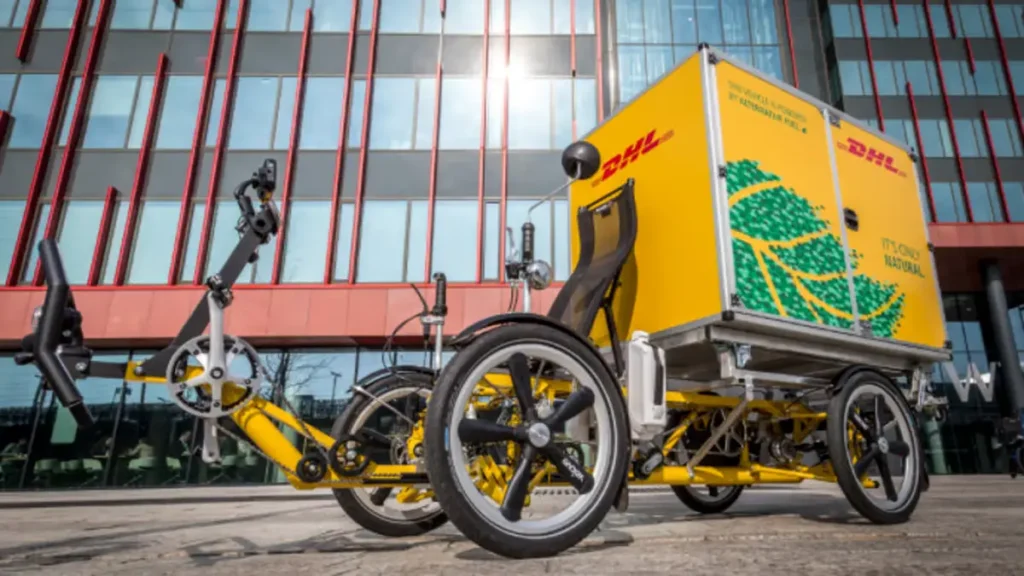
Example of a four-wheeled cargo e-bike (Velove Armadillo) being used for urban deliveries. Though a quad-cycle, its front seating and long cargo box evoke the Long John concept, scaled up for heavy loads.
Use Cases: Two-wheeled front-loaders are extremely popular for last-mile parcel deliveries and grocery services in urban areas. Their agility lets couriers weave through traffic and park right at storefronts or doorsteps. For instance, Urban Arrow cargo bikes are used by courier companies in Amsterdam and London to replace vans for downtown deliveries. Grocery delivery startups and supermarkets (like Dutch online grocer Crisp in Amsterdam) use front-loader e-bikes with insulated boxes to distribute orders in city neighborhoods. The typical ~125 kg payload is sufficient for several packages or multiple grocery orders per trip. These bikes are also common in postal services for mail and small parcel rounds; postal workers appreciate their bike-like handling and the ability to cover ~50 km routes on a charge. In urban centers across Europe, front-loading e-cargo bikes have become “the station wagons of bikes” – able to carry substantial loads while still fitting in bike lanes and low-emission zones that restrict vans.
Approximate Specs & Prices (2-Wheel Front-Loaders):
| Model & Brand | Front Box Volume / Payload | Motor & Battery | Range (est.) | Approx. Price (EUR) |
|---|---|---|---|---|
| Urban Arrow Cargo L (NL) | 250 L box; 125 kg payload | Bosch Cargo Line (85 Nm), 500 Wh | ~50 km (single batt) | ~€5,000 – €6,000 |
| R&M Packster 70 (DE) | 240 L box; ~100–125 kg payload | Bosch Cargo (Gen4), 500–1000 Wh | 50–70 km (dual batt option) | ~€7,000 – €9,000 |
| Larry vs Harry eBullitt (DK) | 160 L (open platform or box); 100 kg cargo (180 kg GVW) | Shimano EP8 or Bosch, 500 Wh | ~50 km | ~€5,500 – €7,000 |
| Babboe Pro Bike-E (NL) | 150–200 L; ~80 kg payload | Yamaha 250W mid-drive, 400 Wh | ~40 km | ~€4,000 – €5,500 |
| Tern GSD (Long-tail, TW) | (Not front-box; long-tail) 200 kg GVW (100 kg cargo) | Bosch Cargo Line, dual battery (1000 Wh) | 70–100 km (with dual batt) | ~€5,400+ |
Table Notes: Long John-style bikes carry cargo in a front box except the Tern GSD, which is a long-tail (rear cargo rack) design but included for comparison. Payload for two-wheelers refers to cargo weight in the carrier; “GVW” includes rider+bike. Range will vary with load and terrain; figures assume moderate load on flat urban routes. Prices are base MSRP for electric versions (actual cost can increase with accessories like cargo boxes, covers, etc.).
Two-Wheeled Long-Tail Cargo Bikes
Description: Long-tail cargo e-bikes look more like a stretched bicycle: they have an extended rear rack or lengthened wheelbase to accommodate cargo or passengers over the back wheel, instead of a front box. While not as iconic as the bakfiets, long-tails are very practical – essentially a bike “pickup truck” with a large rack or deck over the rear tire. They ride similarly to a normal bike, since the cargo load is behind the rider, and are usually shorter in length than front-loaders, improving maneuverability and storage. Long-tails often use 20-inch rear wheels (for lower center of gravity) and can carry cargo panniers, platform loads, or child seats on the rear.
Key Features: A robust long-tail can handle 180–200 kg gross weight (including rider). For example, the Tern GSD is rated for 200 kg GVW, with up to 100 kg on the rear rack alone. These bikes commonly feature Bosch or similar mid-drive motors with high torque, as they may carry an adult passenger or heavy gear. Many offer dual battery capability (the GSD supports two batteries for up to 210 km combined range in its latest generation). Payload is flexible: one can mount large pannier bags (some over 100 L capacity each), cargo boxes, or seats. Passenger-carrying is a hallmark – long-tails can fit two child seats or even an adult pillion passenger on back. The smaller wheels and beefy frame improve balance when loaded, and accessories like running boards (footrests), wheel skirts, and seatpads are common.
Notable Models:
Besides Tern GSD (a leader in this category for business and family use), other examples include the Riese & Müller Multicharger (which carries ~60 kg cargo + rider, ~€5k), the Yuba Spicy Curry (long-tail with 150 kg total capacity, often used for deliveries; ~€4k), and the Rad Power RadWagon (a more affordable long-tail e-bike, ~€1.5k–€2k, popular for small businesses). Long-tails are often used by couriers, tradespeople, and services who need a bike that can carry tools or goods but remain compact. For instance, a plumber or electrician might equip a long-tail with toolboxes, or a postal worker could use panniers for mail. Food delivery riders (e.g. pizza or meal delivery) also like long-tails for their agility – a rider can easily hop on/off and maneuver in traffic, with a large insulated box mounted on the rear rack.

Price Range: Approx. €4,000–€6,000 for quality mid-tier models (like Tern, R&M), and €2,000–€3,500 for simpler builds or direct-to-consumer brands. Though slightly cheaper than front-loaders on average (since no big box structure), high-end long-tails still invest in powerful motors and batteries to haul weight.
Three-Wheeled Cargo Bikes (Trikes)
Description: Three-wheeled cargo bikes, or cargo trikes, add a third wheel to increase stability and payload. There are two main trike configurations: two wheels in front with a cargo box between them (tadpole design), or two wheels in the rear with cargo over the back (delta trike). The front-box trike is more common for freight – it looks like a widened bakfiets, with a large square cargo box or flatbed between two front wheels, and the rider sitting/steering behind it. This layout allows very large volume boxes and stable loading (the bike stands upright on its three wheels even when stopped or parked). The downside is a wider footprint – often near or above 0.9–1.0 meter width – which can be a tight fit in narrow bike lanes or doorways. Steering can be heavy, and turning requires care to avoid tipping (some trikes have tilting mechanisms that lean the wheels in turns to improve stability). Still, with proper design, cargo trikes can safely carry much more weight than two-wheelers.
Key Features: Electric cargo trikes built for commercial use boast very high payload capacities, often 100–250 kg of cargo. Heavy-duty models like the German Radkutsche Musketier can even support up to 300 kg payload on its front platform. Typically they use 250W hub motors or mid-drives tuned for torque, and often have differential drives or dual-motor setups to power two wheels. Batteries are usually larger (e.g. dual 500 Wh) to ensure sufficient range under heavy loads – though range may still be modest (30–50 km) when fully loaded due to weight and higher rolling resistance. Many trikes feature industrial-grade components: e.g. automotive drum or hydraulic brakes on all wheels, beefy suspension on cargo box to protect goods, and lights/turn signals for road visibility (since they operate almost like micro-trucks). The size can accommodate refrigerated boxes for grocery or pharma deliveries, or custom enclosures (some postal trikes have lockable, weatherproof cabins for mail). Speeds are usually kept to 25 km/h or lower for safety.


Only 20 MOQ Bikes to Get Started
Customizable E-Cargo Bike - RS01
Whether you’re a growing brand or a neighborhood store, our heavy-duty cargo bikes are your ticket into the booming world of eco-friendly delivery. Let’s roll!
Notable Examples:
Classic front-load trikes include the Christiania Bikes (from Denmark, known for simple large box trikes), Babboe Pro Trike (Netherlands, with business-focused cargo boxes up to 265 L volume; e‑assist versions cost ~€4–6 k), and Urban Arrow Tender series (see e.g. the Tender 1500 – a semi‑industrial e‑trike with a 1.5 m³ cargo bed and 300 kg carrying capacity, used by some courier fleets). High‑capacity trikes like the Radkutsche Musketier (mentioned above) or Ferla Cargo M (with fridge unit, popular in food vending) target B2B delivery and can approach small electric van capabilities at a fraction of the cost. For postal and city services, specialized trikes have emerged: e.g. Royal Mail’s e‑trikes trial in the UK featured solar panels on the roof to extend battery life, and Swiss Post uses e‑trikes with enclosed rain canopies for mail delivery. These public service trikes are designed for daily all‑weather use, with features like regenerative braking and even solar charging (Royal Mail’s trial trikes had 48 V batteries recharged via mains and two roof‑mounted solar panels).
Use Cases: Cargo trikes shine in scenarios needing maximum payload and volume at bike-scale. Grocery delivery is a prime example: supermarkets and startups deploy e-trikes with insulated or refrigerated cargo boxes to carry many orders in one round. For instance, Carrefour in France has piloted high-volume e-trikes for online groceries, and in Berlin, startup Gorillas used e-trikes (via Dockr leasing) to fulfill rapid grocery orders. Postal services across Europe use thousands of e-trikes: Deutsche Post’s fleet includes 9,000 electric trikes for mail/parcel last-mile. These trikes enable postal workers to carry a full day’s mail and small parcels (much more than a two-wheeler could) while moving easily through city streets and stopping frequently. Parcel couriers also integrate trikes via city micro-hubs – parcels are dropped by truck at a central depot and then distributed by e-trike to nearby neighborhoods, reducing van mileage. Companies like UPS have used e-trikes in cities for a decade (first in Hamburg in 2012), and UPS’s recent e-trike in Basel carries a large lockable box for downtown deliveries. Municipal services (like waste collection in parks or street cleaning) are another niche: some cities replaced small diesel carts with cargo trikes or quads for hauling tools and waste bins around pedestrian zones.
Approximate Specs & Prices (3-Wheel Cargo Trikes):
| Model / Type | Payload Capacity | Battery/Range | Notable Features | Price (EUR) |
|---|---|---|---|---|
| Babboe Pro Trike XL (front-box) | 100 kg cargo; ~265 L volume | 36V/450Wh; ~30 km range (1 batt) | Large front box (lockable), basic suspension | ~€5,000 – €6,500 |
| Radkutsche Musketier (front flatbed) | 250–300 kg payload | Dual 48V batteries; ~40+ km | Heavy-duty frame, various modules (flatbed, box); 68 kg bike weight | ~€7,000 – €9,500 |
| Urban Arrow Tender 1500 (front-box) | 300 kg payload (1.5 m³ volume) | Bosch Performance CX, 1000 Wh; ~40 km | Three-wheel chassis, automotive tires, Rohloff 14-speed hub | ~€7,000 – €8,000 (base) |
| ONO eCargobike (Delta trike w/cabin) | 200 kg payload (2 m³ module) | 1.4 kWh swappable; ~30–50 km | Enclosed cab, swappable cargo pods, dual hub motors (2×125W) | (Lease/business pricing, est. €10k+) |
| Vok XL (Trike, enclosed) | 200 kg payload | 72V system; ~100 km max | Estonian-made; 4-wheel drive (?), weather protected, 2 m² cargo space | (Lease only, est. €9k+) |
Table Notes: “Range” for trikes assumes one battery; many have option to add capacity. Some high-end trikes (ONO, Vok) are offered via leasing programs rather than direct sale, so prices are approximate. Features like enclosed cabins or swappable containers blur the line between trikes and micro-vans – these are reflected in higher costs. Simpler open-box trikes (Babboe) are more affordable but carry less weight.
Four-Wheeled Cargo Bikes (Quadricycles)
Description: The latest evolution in pedal-powered logistics is the four-wheeled e-cargo bike, essentially a pedal-assisted quadricycle. These have two wheels in front and two in back, providing car-like stability and even greater payload capacity. Quads often feature a recumbent or semi-recumbent seating position for the rider, and an extended chassis that can hold a modular cargo container – sometimes the same size as a small pallet or industrial bin. Despite having four wheels, many are legally classified as e-bikes (pedelecs) by keeping weight and speed within certain limits, allowing them to use bike lanes and avoid needing a driver’s license. The design goal is to replace vans for urban deliveries by offering similar volume and payload in a bike format. Quads are typically wider and longer than other cargo bikes (often ~0.8–1.0 m wide, 2.5–3 m long), yet manufacturers strive to keep them narrow enough for cycle infrastructure and maneuverability.
Key Features: Cargo quads carry impressive loads – for instance, the UPS “eQuad” developed by Fernhay has a capacity of 210 kg in its lockable cargo box. Volume can be around 1–2 m³, rivaling a van’s cargo bay. Because pedaling such weight is hard, quads use powerful electric assist (250W nominal, higher peak) and often multiple motors or all-wheel drive. The Fernhay eQuad uses a pedal-assist motor and perhaps hub motors, giving it enough boost while still adhering to EU e-bike rules (25 km/h). The Velove Armadillo, a pioneering Swedish quad, uses a 250W Bosch mid-drive paired with a 14-speed gear hub, and can haul 125–150 kg in a 1 m³ rear cargo box. Suspension is crucial: quads often include automotive-style suspension on each wheel to protect cargo and improve handling given their size. Most have brake lights, turn signals, and mirrors, bridging bicycle and vehicle equipment standards. Batteries are usually modular; some quads carry multiple batteries to achieve ranges of 50–60+ km. For example, the UPS/Fernhay eQuad manages ~60 km per charge with a standard plug recharge, and the EAV P1 quad can cover 60 miles (96 km) in a day with swap or recharge breaks. Quads often have enclosed rider cabins or weather protection, allowing all-season use (important for postal or parcel use in rain and cold).
Notable Models: Key examples of four-wheeled cargo bikes in Europe include:
- Velove Armadillo (Sweden): A recumbent-style quadricycle with a rear cargo platform. DHL nicknamed it the “Cubicycle” and piloted it in several cities. The Armadillo is 86 cm wide (fits bike lanes) and has a detachable cargo container the size of a EU pallet footprint. Max payload ~150 kg; daily usage by DHL saw ~125 kg loaded and ~50 km covered per courier shift. Its 67 kg lightweight frame and suspension system make it unusually agile. Velove demonstrated even a semi-trailer attachment for larger loads. Price was not public initially, but such units are likely in the €10,000+ range given their tech.
- Fernhay eQuad (UK): Developed for UPS, this quad has 84 cm width, 3 m length, and an enclosed, lockable cargo box (~1m³). Payload is 210 kg. It’s narrow enough for bike lanes and uses pedal steering and assist, allowing UPS to deploy it without special licenses. UPS has rolled out eQuads in London and other cities, citing their ability to access narrow streets and pedestrian zones where vans can’t. Range ~60 km per charge. These are likely built on order for logistics firms.
- EAV P1 (UK): A quadricycle by Electric Assisted Vehicles Ltd, used by DPD and others. It measures ~2.0 m long by 1.0 m wide, weighs 75 kg, and carries 120 kg payload in a weather-sealed pod. It’s a bio-hybrid with pedal assist to 25 km/h (15 mph) and features like hydraulic brakes, lights, and even body panels made of recyclable hemp-fiber composite. DPD chose it for safety (stable four-wheel design) and driver comfort (enclosed cab with weather protection). The P1 can do about 60 miles per day of stop-and-go deliveries. It demonstrates how quads blur the line with micro EVs while remaining legally bikes.
- ONO Motion (Germany): Although technically a trike (1 front, 2 rear wheels), the ONO has a four-wheel stability feel due to its large cabin and module. It’s worth mention alongside quads for its similar use case: a 2 m³ interchangeable cargo module on the back, a full weatherproof cabin for the rider, and a payload of 200 kg. Many ONOs are used in German cities by DPD and others (52 units deployed in 2022 by DPD Germany). ONO’s concept of swappable cargo pods at a hub is indicative of where cargo bike logistics is heading.
Use Cases: Four-wheeled cargo bikes are ideal for urban parcel logistics on a larger scale. They are often deployed as part of a hub-and-spoke delivery system: a van or container truck brings bulk shipments to a city-center micro-hub, where quads then take over for the final mile. DHL’s use of the Cubicycle (Velove) exemplifies this – standard-size pallet boxes are pre-loaded and simply mounted on the quad for last-mile delivery, then swapped out for a new load. This integration with existing logistics flows (e.g. fitting a pallet footprint) is a big advantage. Express couriers (DHL, UPS, DPD, FedEx) have all trialed or adopted quads to increase stop density in busy cities where vans waste time in traffic or searching for parking. Grocery chains and retailers are also exploring quads for larger-scale local deliveries; for example, Amazon in London uses e-cargo bike fleets (some effectively quadricycle-sized) to replace thousands of van trips. Some European cities even employ quadricycles for municipal tasks: in Paris, a borough’s street-cleaning team uses electric quads with water tanks and brooms attached – reducing noise and pollution on narrow streets. The quads’ ability to carry larger, heavier loads (200+ kg) means they can take on deliveries that previously required a van, yet they maintain the benefit of cycling infrastructure access and zero tailpipe emissions. They are especially effective in zero-emission zones where combustion vehicles are restricted; a fleet of e-quads can ensure compliance with green regulations while maintaining delivery capacity.
Approximate Specs & Prices (4-Wheel Quads):
| Model (Quadricycle) | Payload / Volume | Range (assist) | Notable Features | Est. Cost (EUR) |
|---|---|---|---|---|
| DHL Cubicycle (Velove Armadillo) | 125–150 kg cargo; ~1 m³ box | ~50 km per charge | 4-wheel recumbent, 250W mid-drive, swap containers, 86 cm wide | ~€12,000 (est., custom program) |
| UPS eQuad (Fernhay) | 210 kg payload; ~1 m³ | ~60 km per charge | 4-wheel upright, fully enclosed box, 84 cm width | (UPS in-house, est. €10k+) |
| EAV P1 (DPD/FedEx) | 120 kg payload; 1.5 m³ volume | ~96 km/day (with breaks) | 4-wheel, enclosed cab, signals/lights, composite body, very stable | ~€10,000 (est.) |
| Citkar Loadster (DE) [Note] | 200 kg payload; 0.65 m³ box | ~50 km (48V batt) | 4-wheel pedal-car, weather roof, now out of production (was ~€9k) | €9,000 (when available) |
Note: The Citkar Loadster was an early German quad-cycle for deliveries (tested by Hermes) – included here as a reference; newer models like the ONO or Vok have effectively taken its place. Costs for quads are typically provided via B2B contracts; figures above are rough estimates when known. Despite high upfront cost, these bikes have low operating costs and can save logistics firms money long-term – one analysis found running an e-cargo bike costs only pennies per km and avoids fuel, parking and congestion charges.
Conclusion
Across Europe, electric cargo bikes – from nimble two-wheeled long johns to high-capacity trikes and quads – are now critical tools in commercial transportation. They enable faster last-mile deliveries, lower operating costs, and huge environmental benefits in urban centers. Postal services, parcel couriers, grocers, and local businesses have all found cargo e-bikes to be effective substitutes for vans for many tasks. Moreover, these bikes open up delivery access to areas where trucks struggle: pedestrian zones, narrow medieval streets, and city centers aiming for zero-emission traffic. Both urban and rural use cases are emerging: while the vast majority of e-cargo bike deployments are in dense cities (for routes under ~10 km), there are pilots using e-bikes for longer distances with relay hubs (even servicing some rural towns from nearby cities via e-bike networks). The technology continues to advance, with designs incorporating automotive-grade engineering (ABS brakes, robust suspensions, modular containers) while retaining legal status as bicycles – a sweet spot of innovation.
In summary, Europe’s logistics landscape is being reshaped by these pedal-assist workhorses. Whether it’s an express parcel in Paris carried by a sleek long-tail bike, fresh groceries in Berlin arriving via a stout front-loader trike, or a postman in rural France doing the rounds on an e-assisted quad, electric cargo bikes are proving their versatility. They exemplify “right-sizing” transport: using the smallest, cleanest vehicle that can do the job. With major cities setting supportive policies (bike lane expansions, cargo bike subsidies, urban vehicle restrictions) and businesses recognizing the efficiency gains, the cargo bike roll-out is poised to keep growing across both urban and even semi-urban Europe. As one industry report put it, the rise of cargo bikes shows that sometimes the smartest transport solutions are modern twists on old ideas – in this case, putting pedals to work to carry the load. By combining human power with electric assist, these commercial cargo bikes are delivering a future of cleaner, faster, and more human-friendly logistics in Europe’s cities and beyond.
Sources:
- Rapid Transition Alliance – Cargo bikes 60% faster than vans, emissions savings
- CyclingIndustry.news – Urban Arrow cargo bikes in DHL and UPS livery, Pon acquisition
- Urban Arrow Support Center – Max load for Urban Arrow front cargo (125 kg front, 250 kg total)
- New Atlas – Velove Armadillo (DHL Cubicycle) specs: 125–150 kg cargo, design for van replacement
- UPS – “eQuad” four-wheel cargo cycle specs (210 kg, 84 cm width, 60 km range)
- Royal Mail Trial – Solar-assisted e-trikes for postal delivery (1.2 m wide, 250W, solar panels)
- BikeBiz – DPD and EAV P1 cargo quad: 120 kg payload, 75kg vehicle, 60-mile range
- ONOMOTION – ONO e-cargobike specs: 200 kg payload, 2 m³ module, 1.4 kWh battery, 25 km range per battery
- Vok Bikes – Vok cargo trike models: 120 kg for compact S, 200 kg for XL, 100 km range
- CargoBike Database – Radkutsche Musketier: 68 kg weight, up to 300 kg payload (non-electric base)
- Urban Rider (Urban Arrow dealer) – Urban Arrow Tender 1500: 300 kg capacity, Bosch CX, Rohloff – price starting ~$6,399
- Tern Bicycles – GSD long-tail max gross weight 200 kg, rear rack 100 kg
- Electrek – Tern GSD Gen3 updates: 210 kg GVW, dual battery, ABS brakes, starting price
$4,999 (€5,399) - Parcel&Postal Tech Intl – Deutsche Post DHL plans 8,000 e-bikes and 9,000 e-trikes in Germany for deliveries
- PeopleForBikes – Deutsche Post DHL fleet of 17,000 cargo bikes/trikes; Amazon expanding e-cargo bike deliveries in UK
Image Copyright Disclaimer
Some images used on this website/article are sourced from the internet and are intended solely for illustrative and educational purposes to enhance content understanding. We respect the intellectual property rights of original creators and strive to credit sources where applicable.
If you are the rightful owner of any image displayed here and believe its use constitutes a copyright infringement, please contact us at info@regencargobikes.com. Upon verification, we will promptly remove the image or provide appropriate attribution.
Thank you for your understanding.
© Regen Technology Co., Ltd.


